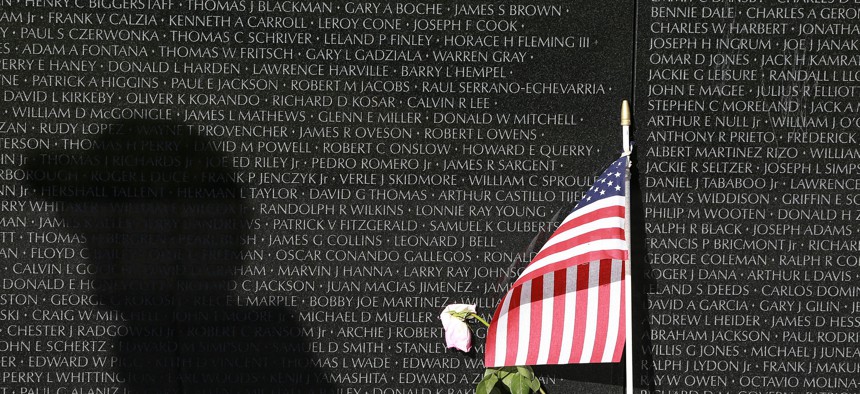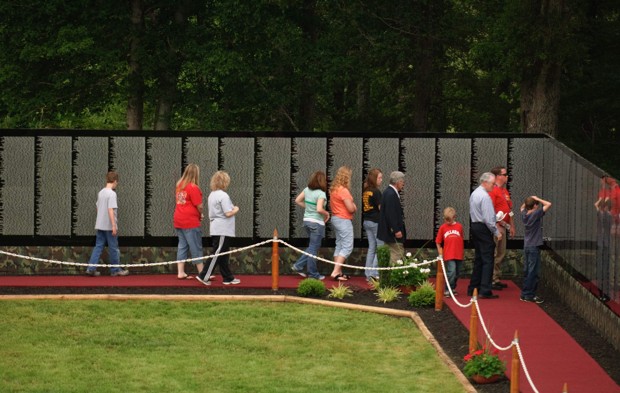
Veterans Affairs Department file photo
Why Are There So Many Copies of the Vietnam Veterans Memorial Wall?
There are multiple copies and even traveling versions of the wall. This increases access, but does it dilute the meaning of the monument?
The U.S. Army needs a copy of the Vietnam Veterans Memorial, and it needs it fast.
On Friday, the Army posted a solicitation for a replica of the Vietnam Veterans Memorial Wall. The National Training Center at Fort Irwin, California, needs a memorial—something just like the famous wall designed by Maya Lin—from March 16 to March 20. The bidding period ends on February 29.
Fort Irwin isn’t looking for a full-scale replica: This one should not be larger than 250 feet in length, or half the size of the (national) Vietnam Veterans Memorial Wall on the National Mall. The replica will nevertheless bear all 58,300-plus names of veterans lost or missing in the war. For all intents and purposes, Fort Irwin is asking for a temporary national memorial of its own to celebrate the 50th anniversary of the Vietnam War.
“It's our chance to say thank you to those who served and didn't get a warm reception when they returned from war,” says Kenneth Drylie, interim director for public affairs for the National Training Center and Fort Irwin.
Fortunately for Fort Irwin, plenty of vendors can answer the bid. There are at least four different groups that build and transport replicas of the Vietnam Veterans Memorial wall. One of the organizations, the Moving Wall, operates three half-sized replicas. Two of the walls are stored in White Pine, Michigan, until the kickoff of the 2016 touring season in April; in 2015, these Moving Wall installations visited sites in 16 states. (The third replica wall, which is now “retired,” is permanently based at Pittsburg State University in Pittsburg, Kansas.)
There are more touring Vietnam Walls out there. The Traveling Wall, a 3/5 replica of the memorial, will visit sites across eight states in 2016. The American Veterans Traveling Tribute boasts a roving replica that is 80 percent of the size of the original. The Vietnam Veterans Memorial Fund’s The Wall That Heals has visited more than 400 cities since 1996. Between all the various memorial-wall replicas out there, on any given summer day, states are as likely to have their own Vietnam Veterans Memorial walls as not.
“With flexible scheduling, limited sponsor requirements and the best customer service, it’s easy to see why we are the #1 booked and most visited Traveling Vietnam Wall Replica,” reads the American Veterans Traveling Tribute site.

Some communities have not been willing to settle for a traveling replica, so they have built permanent imitations instead. Visitors to the Healing Fields of Honor in Naperville, Illinois, described its new Vietnam Veterans Memorial wall—a full-scale copy of Lin’s original design—as “hallowed ground” when it opened in November. Planners behind a Vietnam Veterans Memorial wall replica for southern Oregon can’t quite agree on a location in or around Central Point. There are standing replica memorials in Pensacola, Florida;Wildwood, New Jersey; and other cities.
Arguably, there’s something about Lin’s design that gets lost in replication. Many of the planned and temporary memorials across the nation can’t boast the same acreage as the Vietnam Veterans Memorial, for starters. None of them carries with it the same grandeur as the National Mall, where, around so much gleaming white commemorative marble, Lin’s Vietnam tribute reads like a scar across the landscape. A replica just can’t convey the audacity of the original.
All the imitations around the country speak to the clarity of Lin’s original design concept. Her visual vocabulary was stark. It’s easy to understand what you’re supposed to do at the Vietnam Veterans Memorial, which isn’t always true of other memorials on the Mall, older and newer ones alike. So it’s easy to see why communities would want to take part of that home.
But the memorial’s popularity perhaps owes to its dilution over time as well. No one would think today to describe the Vietnam Veterans Memorial as “Orwellian glop” or “a black gash of shame”—as the critics put it shortly after the design debuted. Polished black granite inscribed with the names of the dead is still a stark visual, but less so with every iteration. The wall doesn’t mean the same thing to me as it does to my dad. Surely for Millennials, the idea of the Vietnam War is even foggier and more remote.
That’s how history goes. Maybe touring Vietnam memorials is one way to preserve the national memory of a shameful war. And of course, for a veteran or family member who never has the luxury of visiting the nation’s capital, the difference in the value proposition between the replica and the original may be marginal. More replicas mean more access to the function of memorialization—in this case, tracing a name or leaving an offering of a pack of smokes.
That function of memorialization is personal for walls in a way that’s hardly ever true of statues or obelisks, at least today. Whether that function can be described as healing or nostalgia, remembrance or performed grief, is up for judgment. One element that a national memorial provides that a local memorial cannot, though, is clarity—considered, debated, adjudicated, and designed. That’s different from access. There could be Vietnam Veterans Memorial walls in every city in the nation; they wouldn’t add up to the one.
NEXT STORY: What's New in Obama's Plan to Close Guantanamo






